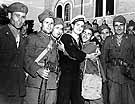
|
|
|

|

|

|

|
|
Click on an image to see a larger, more detailed picture.
|
|
|
|
|
| 1943: Death and Resistance |

|
pg. 488 |

|
|
|
|
| |
 An Italian soldier and Italian sailor hug as they celebrate the announcement that Italy has declared war on Germany. For many soldiers, their rejoicing would be short-lived. Italy's new government, headed by Marshal Pietro Badoglio, surrendered to the Allies on September 8, and five weeks later King Victor Emmanuel III took the next step, declaring war on Germany. As a result, hundreds of thousands of Italian soldiers in the regions controlled by German troops were disarmed by the Germans and sent to internment camps. Thousands perished.
An Italian soldier and Italian sailor hug as they celebrate the announcement that Italy has declared war on Germany. For many soldiers, their rejoicing would be short-lived. Italy's new government, headed by Marshal Pietro Badoglio, surrendered to the Allies on September 8, and five weeks later King Victor Emmanuel III took the next step, declaring war on Germany. As a result, hundreds of thousands of Italian soldiers in the regions controlled by German troops were disarmed by the Germans and sent to internment camps. Thousands perished.
Photo: AP/Wide World
|
 A Jew, recently apprehended by a Danish Nazi (center, in black raincoat and hat), is rescued by his fellow Danes. As the Nazi escorted the Jew through the streets, an angry crowd forced him to surrender his prisoner to the Danish police. Once safely inside the police station, the gendarmes helped the Jew escape. The Danish police consistently refused to cooperate with the German occupation authorities.
A Jew, recently apprehended by a Danish Nazi (center, in black raincoat and hat), is rescued by his fellow Danes. As the Nazi escorted the Jew through the streets, an angry crowd forced him to surrender his prisoner to the Danish police. Once safely inside the police station, the gendarmes helped the Jew escape. The Danish police consistently refused to cooperate with the German occupation authorities.
Photo: Frihedsmuseet / United States Holocaust Memorial Museum Photo Archive
|
 Danish fishermen ferry a boatload of Jewish fugitives across a narrow sound to neutral Sweden during the nationwide rescue operation. News of impending deportations of Jews spawned a rapid response by the Danes, who worked feverishly to save Jewish citizens. Boats of every size and shape were used to transport the Jews from Denmark to Sweden, away from the grasp of the Nazis.
Danish fishermen ferry a boatload of Jewish fugitives across a narrow sound to neutral Sweden during the nationwide rescue operation. News of impending deportations of Jews spawned a rapid response by the Danes, who worked feverishly to save Jewish citizens. Boats of every size and shape were used to transport the Jews from Denmark to Sweden, away from the grasp of the Nazis.
Photo: Frihedsmuseet / United States Holocaust Memorial Museum Photo Archive
|
|

|

|

|

|
 October 11, 1943: At the Sobibór death camp, new arrivals panic and run toward barbed wire, only to be machine-gunned by guards.
October 11, 1943: At the Sobibór death camp, new arrivals panic and run toward barbed wire, only to be machine-gunned by guards.
|
 October 13, 1943: Italy declares war on Germany.
October 13, 1943: Italy declares war on Germany.
|
 October 13, 1943: Hatchets, knives, and warm clothing are secretly distributed among inmates at the Sobibór death camp; See October 14, 1943.
October 13, 1943: Hatchets, knives, and warm clothing are secretly distributed among inmates at the Sobibór death camp; See October 14, 1943.
|
 October 14, 1943: Leon Feldhendler and Jewish Soviet officer Aleksandr Pechersky, interned at the Sobibór death camp since Septem-ber, instigate an inmate revolt and escape, during which 11 German SS guards and two or three Ukrainian SS guards are killed. Two hundred of 600 Jews in the camp are killed by gunfire and exploding mines; among them is 33-year-old Dutch painter Max Van Dam. Of the 300 who escape, only 100 are recaptured; many of the remaining 200 escapees join Soviet partisan forces. Of these, only 50 to 70, including Pechersky, will survive the war; See October 16, 1943.
October 14, 1943: Leon Feldhendler and Jewish Soviet officer Aleksandr Pechersky, interned at the Sobibór death camp since Septem-ber, instigate an inmate revolt and escape, during which 11 German SS guards and two or three Ukrainian SS guards are killed. Two hundred of 600 Jews in the camp are killed by gunfire and exploding mines; among them is 33-year-old Dutch painter Max Van Dam. Of the 300 who escape, only 100 are recaptured; many of the remaining 200 escapees join Soviet partisan forces. Of these, only 50 to 70, including Pechersky, will survive the war; See October 16, 1943.
|
|
|
|
|
| 1943: Death and Resistance |

|
pg. 488 |

|
|
The Holocaust Chronicle
© 2009 Publications International, Ltd.
|
|
